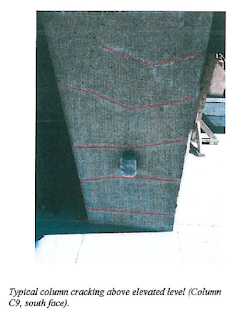"The size of the concrete structure whether it is a bridge, a highway, or a building does not make it immune to the effects of temperature. ... Severe problems develop in massive structures where heat cannot be dissipated. Thermal contraction on the concrete’s surface without a corresponding change in its interior temperature will cause a thermal differential and potentially lead to cracking. Temperature changes that result in shortening will crack concrete members that are held in place or restrained by another part of the structure, internal reinforcement or by the ground. ... Joints are the most effective way to control cracking." http://www.engr.psu.edu/ce/courses/ce584/concrete/library/cracking/thermalexpansioncontraction/thermalexpcontr.htm
Even though I understand exactly what the KCE report is saying, I am surprised by the report’s indirect wording that the SSTC doesn’t have any expansion joints (e.g. pgs. 5, 14, 19, 36, 46).
Why didn’t KCE come right out and say it: “The 315 ft. wide by 580 ft. long SSTC doesn’t have any expansion joints despite the fact that WMATA’s design and construction standards, to which the SSTC was supposed to have been designed and constructed, require expansion joints to be located no more than 100 ft. apart.”?
The entire structure is cracked, just as one would expect of a 315 ft. by 580 ft. concrete monolith that doesn't have any expansion joints.
The average coefficient of expansion/contraction for concrete structures is approximately 0.0000055 inch change in length per inch of total length per degree change in degrees Fahrenheit. Temperatures in Washington DC can reach above 100 degrees Fahrenheit in the summer (with the temperature of the surface of the SSTC's exposed concrete deck being tens of degrees greater) and below 20 degrees Fahrenheit in the winter. If the 315 ft. wide by 580 ft. long SSTC was unrestrained, then it would undergo a 1.66 inches change in width and a 3.06 inches change in length with an 80 degree temperature swing.
But, the SSTC is restrained without expansion joints. Can you imagine the force on the restrained slabs, beams, girders and columns when the 315 ft. wide by 580 ft. long SSTC tries to expand and contract 1.66 inches and 3.06 inches respectively? Enough to make concrete crack! Have you ever tried to crack a 12 inch thick piece of concrete? It takes a LOT of force!
Putting an epoxy overlay on the decks won't stop the deck slabs from cracking. Externally bracing some beams won't stop beams from cracking. Doing nothing to address cracking in girders and columns won't stop them from cracking either.
The SSTC will continue to crack. Why? Because it gets hot in the summer and cold in the winter, and because the 315 ft. wide by 580 ft. long SSTC is "over-restrained", not allowing it to expand in summer's heat and contract in winter's cold without cracking. Why is the SSTC "over-restrained"? Because the 315 ft. wide by 580 ft. long concrete monolith doesn't have any expansion joints! Simple.
Why don't they retrofit the SSTC to add expansion joints? That's not so simple. The SSTC is one, giant, massive, concrete, monolith. If it had expansion joints (like WMATA design and construction standards require), then it would be at least 24 separate structures with gaps (expansion joints) in between to allow for expansion in the summer and contraction in the winter.
How does one retrofit a concrete structure that was designed and built as one, massive, concrete monolith into 24 separate structures--after the fact? How would one cut a 4-legged table, permanently anchored to the floor underneath it, into 24 smaller tables without the larger table collapsing in the process? How does one retrofit the SSTC into 24 smaller, separate structures? I have no idea, other than to tear it down and start over. Even if there is a way to retrofit the SSTC with expansion joints no farther than 100 ft. apart (like WMATA design and construction standards require), would it be practical and cost effective to do so? Or, would it be more practical and cheaper to tear the SSTC down and start all over again?
Did Montgomery County review KCE’s report before it was finalized? Did an earlier draft have more direct language stating that the SSTC doesn’t have any expansion joints? Did Montgomery County ask that the direct wording be changed? Did KCE change direct language in an earlier draft not wishing to “bite the hand that feeds them”?
I don’t know the answer to these questions; but, I find it strange that KCE’s report, Montgomery County officials, their paid and unpaid consultants, WMATA, and the news media haven't stated more clearly that the SSTC's severe cracking is the result of its complete lack of expansion joints.
Silver Spring Transit Center
Paul S. Sarbanes Transit Center
Montgomery County MD
public-private partnership
crony capitalism
WMATA
Maryland Transit Administration (MTA)
Federal Transit Administration (FTA)
Purple Line
Gov. Hogan


















